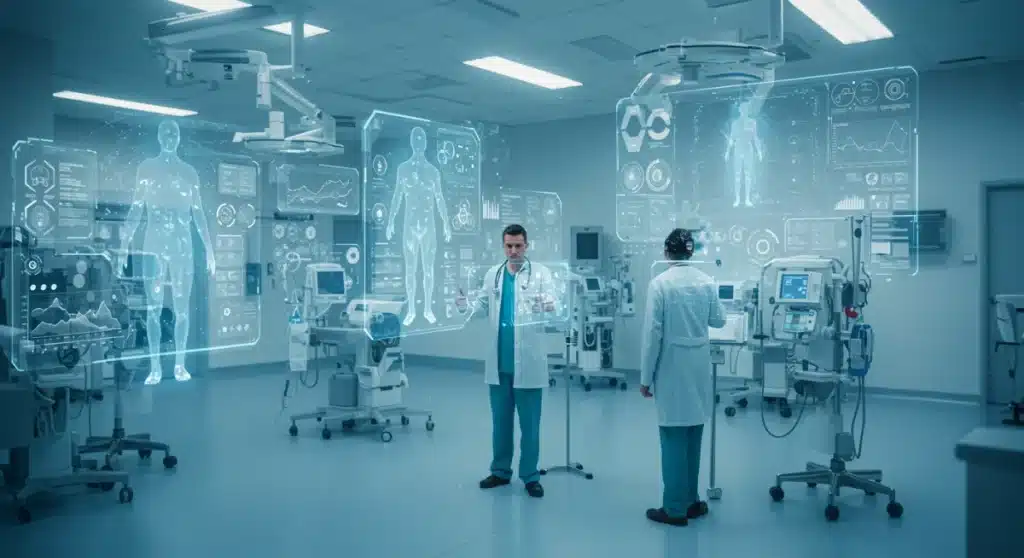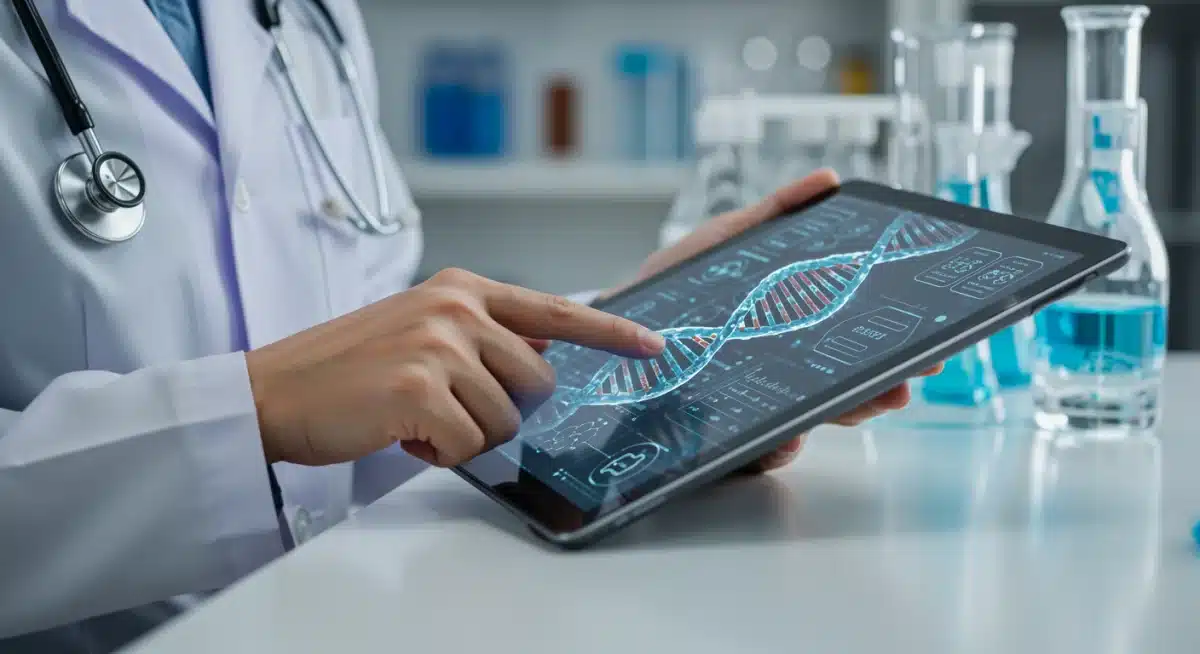Future Healthcare: 4 Predictive Techs to Cut US Costs by 5% by 2027

Four predictive technologies are set to revolutionize US patient care by 2027, aiming to reduce healthcare costs by 5% through enhanced early detection, personalized treatment, and proactive health management.
As of late 2023, the landscape of American medicine is on the cusp of a significant transformation. Projections indicate that The Future of Healthcare: 4 Predictive Technologies Set to Transform US Patient Care by 2027, Reducing Costs by 5%, marking a pivotal shift towards proactive and personalized medical interventions. This imminent change promises not only better patient outcomes but also substantial economic benefits, driven by cutting-edge innovations.
Artificial Intelligence (AI) in Early Disease Detection
Artificial Intelligence (AI) is rapidly emerging as a cornerstone for early disease detection, offering unprecedented capabilities to analyze vast datasets and identify subtle patterns indicative of health risks. This technology is already being implemented in various pilot programs across the US, showcasing its potential to catch diseases like cancer and cardiovascular conditions far earlier than traditional methods.
The integration of AI algorithms into diagnostic imaging and electronic health records (EHRs) is proving instrumental. These systems can process complex information, such as radiological scans, genetic markers, and patient history, to flag potential issues that might otherwise go unnoticed by human observation alone.
Enhanced Diagnostic Accuracy
AI’s ability to sift through millions of data points rapidly significantly boosts diagnostic accuracy. This is particularly crucial in fields requiring detailed image analysis or complex data interpretation.
- Radiology: AI assists in detecting anomalies in X-rays, MRIs, and CT scans, often identifying cancerous lesions at earlier, more treatable stages.
- Pathology: Machine learning models analyze tissue samples, improving the precision of disease classification and prognosis.
- Ophthalmology: AI can detect early signs of diabetic retinopathy and other eye conditions, preventing vision loss.
Predictive Analytics for Risk Assessment
Beyond diagnostics, AI excels in predictive analytics, assessing individual patient risk profiles. By leveraging historical data and real-time inputs, AI can forecast a patient’s likelihood of developing certain conditions or experiencing adverse events.
This predictive capability empowers healthcare providers to intervene proactively, implementing preventive measures or personalized screening schedules. For instance, AI models can predict readmission risks for hospital patients, allowing for targeted post-discharge care to reduce unnecessary hospitalizations.
Genomic Sequencing and Personalized Medicine
Genomic sequencing is set to redefine personalized medicine, moving away from a one-size-fits-all approach to treatments tailored to an individual’s unique genetic makeup. This technology provides a detailed blueprint of a person’s DNA, revealing predispositions to diseases and how they might respond to specific medications.
By 2027, the cost of sequencing a human genome is expected to drop significantly, making it more accessible for routine clinical use. This affordability will unlock new avenues for disease prevention and highly effective targeted therapies, especially in oncology and pharmacogenomics.
Tailored Treatment Plans
Understanding a patient’s genetic profile allows clinicians to devise highly effective and less toxic treatment plans. This is particularly transformative in cancer care, where genetic mutations drive disease progression.
- Oncology: Genomic profiling identifies specific mutations in cancer cells, guiding the selection of targeted therapies that are more effective and have fewer side effects than traditional chemotherapy.
- Pharmacogenomics: This field uses genetic information to predict a patient’s response to drugs, optimizing dosages and avoiding adverse drug reactions.

Early Disease Predisposition Identification
Genomic sequencing can identify genetic predispositions to a wide range of conditions long before symptoms appear. This allows for early lifestyle interventions, increased surveillance, and preventive measures.
For example, individuals with a genetic risk for certain cardiovascular diseases can adopt healthier habits or begin prophylactic treatments earlier. This proactive approach not only improves long-term health outcomes but also reduces the need for expensive, acute care interventions down the line.
Remote Patient Monitoring (RPM) and Wearable Devices
Remote Patient Monitoring (RPM) combined with advanced wearable devices is revolutionizing how chronic conditions are managed and how patients interact with their healthcare providers. This technology enables continuous data collection from patients outside traditional clinical settings, providing real-time insights into their health status.
The proliferation of smartwatches, continuous glucose monitors, blood pressure cuffs, and other connected devices is transforming episodic care into continuous, proactive health management. This shift is particularly beneficial for managing chronic diseases like diabetes, hypertension, and heart failure.
Continuous Health Data Collection
RPM systems gather vital health metrics around the clock, offering a comprehensive view of a patient’s physiological state. This continuous stream of data helps identify deviations from baseline earlier, allowing for timely interventions.
- Cardiovascular Health: Wearable ECG monitors detect arrhythmias and other cardiac abnormalities, alerting both patients and clinicians.
- Diabetes Management: Continuous glucose monitors provide real-time blood sugar levels, helping patients and doctors manage insulin and diet more effectively.
- Post-Surgical Recovery: RPM tracks recovery metrics, ensuring adherence to rehabilitation protocols and detecting complications early.
Proactive Intervention and Reduced Hospitalizations
The ability to monitor patients remotely allows healthcare teams to intervene proactively when early warning signs emerge, often preventing the escalation of conditions that would otherwise necessitate emergency room visits or hospital admissions. This significantly contributes to cost reduction.
For example, a sudden spike in a patient’s blood pressure, detected by an RPM device, can trigger an immediate telehealth consultation, leading to medication adjustments that prevent a hypertensive crisis. This proactive model reduces the burden on acute care facilities and improves patient quality of life.
Digital Twin Technology for Personalized Treatment Simulation
Digital twin technology, a concept borrowed from engineering, is making its way into healthcare, promising to create highly personalized virtual models of patients. These ‘digital twins’ are dynamic, data-driven replicas of an individual’s physiology, allowing for the simulation of various treatments and interventions before they are applied to the actual patient.
By 2027, digital twins are expected to be sophisticated enough to integrate real-time data from wearables, EHRs, genomic profiles, and imaging scans, creating an incredibly accurate and evolving representation of a patient’s health. This technology holds immense potential for optimizing drug dosages, predicting surgical outcomes, and personalizing rehabilitation programs.
Virtual Treatment Testing
One of the most significant advantages of digital twins is the ability to virtually test different treatment protocols. Clinicians can simulate the effects of various medications, surgical approaches, or lifestyle changes on a patient’s digital twin without any risk to the actual patient.
- Drug Response Prediction: Simulate how a patient’s body will react to different drug compounds and dosages, optimizing efficacy and minimizing side effects.
- Surgical Planning: Practice complex surgical procedures on a patient’s digital twin to refine techniques and anticipate challenges, leading to better real-world outcomes.
Enhanced Disease Modeling and Prevention
Digital twins can also be used to model the progression of diseases within an individual’s body, helping to predict future health trajectories and identify critical intervention points. This allows for highly personalized preventive strategies.
For example, a digital twin can model the impact of different dietary choices or exercise regimens on a patient’s risk for developing type 2 diabetes, providing actionable insights for lifestyle modifications. This level of personalized foresight is a game-changer for long-term health management.
Integrated Data Platforms and Interoperability
The true power of these predictive technologies hinges on robust, integrated data platforms and seamless interoperability across healthcare systems. Without a unified approach to data sharing and analysis, the full potential of AI, genomics, RPM, and digital twins cannot be realized.
Efforts are currently underway to establish secure and standardized data exchange protocols, ensuring that patient information can flow freely and safely between different providers, devices, and analytical tools. This integration is critical for creating comprehensive patient profiles and delivering holistic care.
Unified Patient Records
Integrated data platforms aim to consolidate all relevant patient information into a single, accessible record. This includes clinical notes, lab results, imaging studies, genetic data, and real-time physiological data from wearables.
A unified record eliminates information silos, reduces medical errors caused by incomplete data, and ensures that every healthcare professional involved in a patient’s care has access to the most up-to-date and comprehensive information.
Secure and Ethical Data Sharing
While data sharing is essential, it must be conducted with the utmost attention to security and patient privacy. Blockchain technology and advanced encryption methods are being explored to create secure frameworks for health data exchange, ensuring compliance with regulations like HIPAA.
Ethical guidelines are also being developed to govern the use of predictive technologies, ensuring fairness, transparency, and patient consent in how their data is collected, analyzed, and applied to their care. Public trust in these technologies is paramount for their widespread adoption.
Economic Impact: Reducing Healthcare Costs
The overarching goal of implementing these four predictive technologies is to significantly reduce healthcare costs in the US. The projected 5% reduction by 2027 is a conservative estimate, with some experts predicting even greater savings as these technologies mature and become more widely adopted.
Cost savings are expected to emerge from several key areas, including reduced hospitalizations, fewer emergency room visits, optimization of drug therapies, and the prevention of chronic disease progression. This shift from reactive, expensive treatments to proactive, preventive care is fundamental to financial sustainability.
Preventive Care and Early Intervention
By preventing diseases or catching them at their earliest stages, the need for costly acute care, complex surgeries, and long-term management of advanced conditions diminishes significantly. Early detection, fueled by AI and genomics, allows for less invasive and more affordable treatments.
RPM also plays a crucial role by enabling continuous monitoring and timely interventions for chronic conditions, thereby averting costly complications and hospital readmissions.
Optimized Resource Allocation
Predictive analytics helps healthcare systems allocate resources more efficiently. By identifying patients at high risk, providers can direct preventive services and support to those who need it most, avoiding unnecessary expenditures on low-risk individuals.
- Staffing: Predictive models can forecast patient influx, optimizing staffing levels in hospitals and clinics.
- Supply Chain: AI-driven analytics can improve medical supply chain management, reducing waste and ensuring availability of critical resources.
- Treatment Pathways: Digital twins help refine treatment pathways, ensuring that the most effective and cost-efficient interventions are chosen from the outset.
| Key Technology | Impact on Healthcare by 2027 |
|---|---|
| Artificial Intelligence (AI) | Enhances early disease detection and diagnostic accuracy, leading to timely interventions and improved outcomes. |
| Genomic Sequencing | Enables personalized medicine, tailoring treatments based on individual genetic makeup, reducing adverse reactions. |
| Remote Patient Monitoring (RPM) | Provides continuous health data, facilitating proactive interventions and reducing hospitalizations for chronic conditions. |
| Digital Twin Technology | Creates virtual patient models for simulating treatments and predicting outcomes, optimizing care pathways. |
Frequently Asked Questions About Predictive Healthcare
The main goals are to enhance early disease detection, personalize treatment plans, improve patient outcomes, and significantly reduce overall healthcare costs by shifting towards a more proactive and preventive care model.
AI will reduce costs by improving diagnostic accuracy, leading to earlier and less expensive treatments. It also optimizes resource allocation and predicts patient risks, preventing costly emergency interventions and hospital readmissions.
Yes, the cost of genomic sequencing is projected to decrease substantially by 2027, making it more affordable and widely available for routine clinical applications in personalized medicine and disease prevention.
Wearable devices collect continuous real-time health data, enabling proactive management of chronic conditions. They alert healthcare providers to critical changes, facilitating timely interventions and reducing the need for acute care.
Digital twin technology creates virtual models of patients to simulate treatment outcomes. This allows clinicians to test different therapies, optimize drug dosages, and plan surgeries virtually, tailoring care precisely to individual needs.
What Happens Next
The rapid advancement and integration of these predictive technologies signal a fundamental shift in US healthcare, moving towards a system that is not only more efficient but also profoundly personalized. Stakeholders across the industry, from policymakers to technology developers and healthcare providers, are now focused on addressing challenges related to data interoperability, cybersecurity, and ethical guidelines. The coming years will see increased investment in infrastructure to support these innovations, alongside rigorous testing and validation to ensure their safety and effectiveness. Expect ongoing developments in regulatory frameworks and public education to facilitate widespread adoption and maximize the transformative potential of these technologies by 2027 and beyond.





